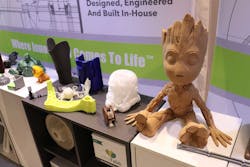I went to IMTS last month with a singular purpose: to find the one standout technology that will shape the manufacturing industry for the next two years.
This has been a bulletproof strategy for every iteration of the event I have attended. We have had cobot years and robot years; we’ve had additive years and hybrid years; we’ve had cryogenic years and we’ve had axes years. And, of course, more recently we’ve had the quick rise of the IIoT.
These tech highlights have always provided a perfect barometer for the industry—by finding the newest tech with the largest crowds, it has been fairly easy to assess where buyers would be spending and where companies would be developing or acquiring, along with the general shape of the future.
This year, however, the plan failed.
From my perspective, there didn’t seem to be any standout technology this year. There were plenty of amazing products and incredible breakthroughs, sure. But there was no sign of a dominant industry or program or application that seemed to be carving out a new path for us.
Instead, I found that all of these disparate, cutting edge innovations of IMTS’ past seem to have merged.
The IIoT no longer stands out, because it is now integrated into seemingly every machine tool, part, and component. Robots—standard, collaborative, mobile, whatever—were just as ubiquitous, tending machines, juggling sports cars, even automating additive processes.
At one point, just to emphasize the point I think, I saw a mobile robot carrying a cobot that was tending a machine tool, all of which was controlled by the IIoT. That’s about as integrated as it gets.
One exchange I had at the show probably sums up my impressions best: During a particular booth tour, the guide asked me if I would be surprised to hear they were using 3D-printed components.
“Honestly,” I said. “I’d be surprised if you weren’t.”
So what does this mean for the industry?
As far as I can tell, it means everything is awesome.
Each of these technologies has independently been hyped as “the future of manufacturing.” Each one of them has been dubbed part of the new “industrial revolution.” Each one of them, we have been told, will change the industry forever just as soon as it matures, just as soon as the greater industry adopts it.
The Best of IMTS 2018 in Pictures
Well now, it seems, the technologies are mature. Now, it seems, the greater industry has adopted them.
Which means things are about to get very, very interesting.
In fact, they already are.
On my flight out of Chicago, crammed into a middle Southwest seat, the closing argument for this whole case cruised right by me: attached to the flight attendants’ drink-laden trays, propping up their order cards as they hurried through the aisles, was a tiny, custom 3D-printed clip.
It was this small thing, this one little piece of additive in the wild, that offered all of the validation I needed. It, along with the endless booths I had explored the days before, sent a clear message: the future is here. The future is now. And it’s going to be fun.











